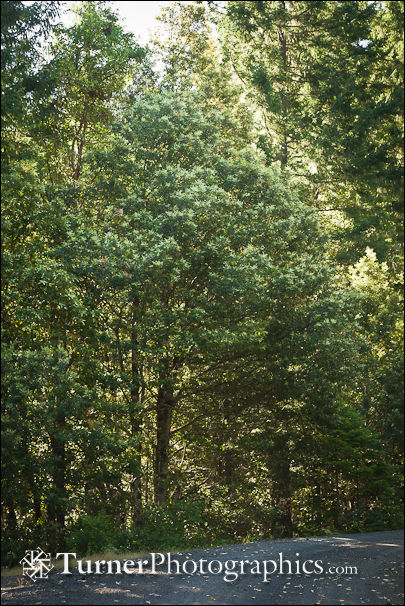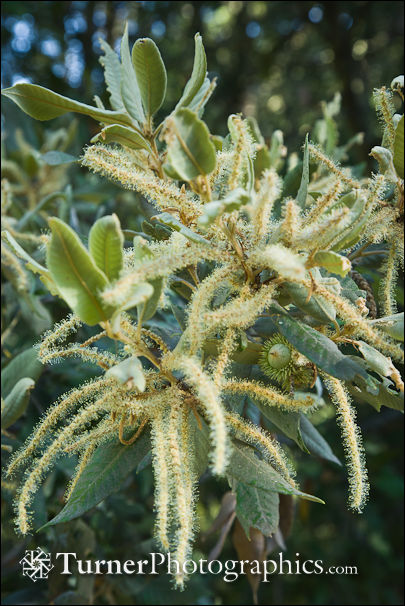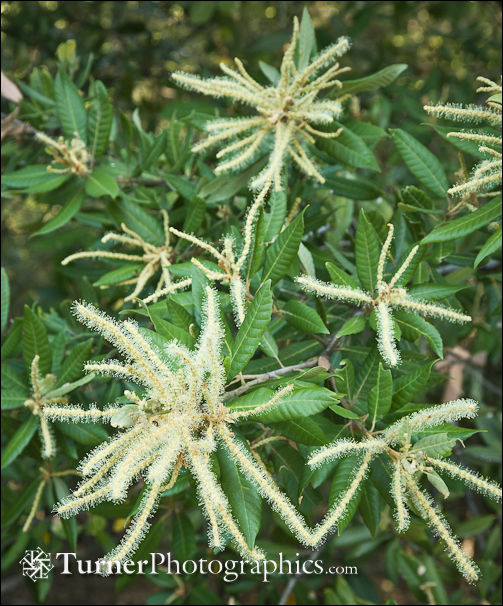Plant of the Month: Tanoak

What looks like an oak, has acorns like an oak, but isn’t an oak? That would be tanoak, Lithocarpus densiflorus, a west coast native. This evergreen tree is also known as tanbark-oak. It has flowers like a chestnut but forms acorns rather than having its nuts enclosed by a spiny bur. Both Lithocarpus and Quercus are in the Beech family, the Fagaceae.
Tanoak is found naturally in southern Oregon and northern California where it is the most abundant hardwood timber tree in the coast ranges. It favors westerly slopes that receive 40 to 100 inches of annual rainfall, most of which comes between November and May. Where soils are shallower and hold less moisture tanoak grows on north slopes, along streams, and in valleys. It sometimes forms almost pure stands, particularly just to the east of the redwood belt.
The tree in the photograph to the right was growing along a Forest Service road above Oregon Caves National Monument south of Cave Junction, Oregon.
In mild climates, tanoak can be a beautiful specimen tree in the home landscape. It grows slowly to about 80 feet, but only reaching 30 feet in 20 years. They’ll grow best in cool, coastal climates with little summer rainfall, mimicking their natural habitat. Tanoaks will be happiest in fertile, deep soil, but with adequate moisture tolerate shallow soils. This is not a tree for northern climates, as they are only hardy down to about 7° F. That means I won’t be planting one in our Bellingham garden where we get an occasional cold snap with temperatures as low as 5° F.

Tanoaks can bloom in the spring, summer, or autumn but generally flower in June, July, and August depending on the elevation. Male flowers are elongated catkins, with the less conspicuous female blossoms at their base. Both are usually borne in the leaf axils of new shoots. In full bloom, tanoaks are quite conspicuous with their catkins glowing in the sun. The specific name, densiflorus, derives from the thick clusters of flowers that sometimes almost obscure the leaves.
Northern California Native Americans used tanoak acorns as an important part of their diet. The acorns are large, 1-2 inches long and over ½ inch diameter, and produced in large quantities. According to the Forest Service publication, Silvics of North America, “The large acorns were ground, leached, and then prepared as a soup, cooked mush, or a kind of bread. After being leached, the acorns are said to have an agreeable acid taste. They also contain a comparatively large amount of oil. On this account, tanoak acorns were preferred by local Indians over all other kinds.”

Tanoak bark is used, along with chestnut and oak, to tan leather. It’s said to be the best choice for tanning heavy leathers like sole and saddle leather.
Tanoak is just one of the trees new to me this year as I travel throughout the northwest photographing trees and shrubs for a new field guide due from Timber Press in 2013.
For more details, see the tanoak entry in Silvics of North America.


Mark:
Don’t forget to mention the strain/subspecies of dwarf tanoak that only grows to 6 to 10 ft high. I have one here on Lopez, growing in a very exposed (to NE) location. Has generally grown well, and made it through our last winter, but did have considerable leaf-drop this summer. Has been in the ground 12 years, and is only about 6 to 6.5 feet tall.
Great work and kudos to you!
Scott, in the forthcoming book we’ll mention the shrub subspecies, which is var. echinoides.